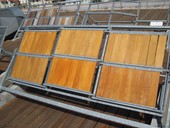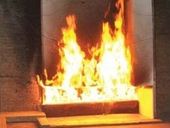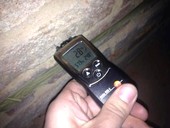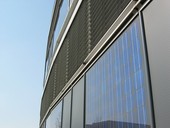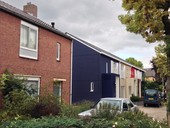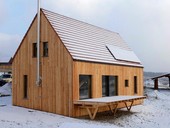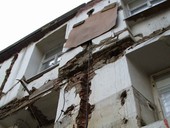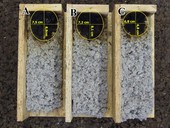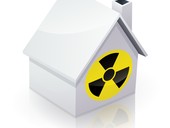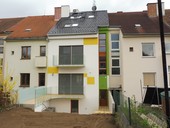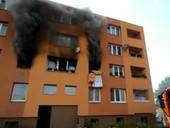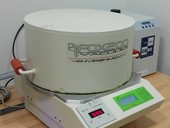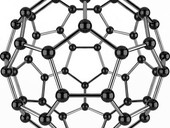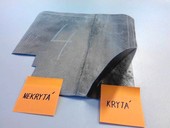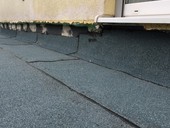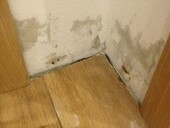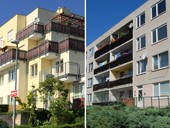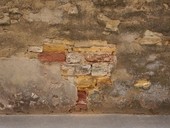Oak wood is characterized by good durability against biotic damages. However, its surface treatment by coatings is problematic, especially in the exterior expositions. In most cases, there is a rapid degradation and damage caused by weathering. Transparent variants of coating systems suffer from this phenomenon even more than pigmented ones. The article contains the results of practical experiments that lead to some general recommendations, which use leads to surface treatment of oak wood in exterior with longer durability and better colour stability.
Archiv článků od 3.4.2017 do 14.1.2019
The article focuses on assessment of fire closure of external walls and is divided into two parts – a current state of knowledge and an experimental part. The current state of knowledge summarises methods for assessing the fire closure of external walls – calculation methods (heat flux density, heat release rate, mathematical models) and fire tests (cone calorimetry, reaction to fire test for facades or fire resistance test). The experimental part builds on the state of knowledge and is divided into two experiments – the test in a cone calorimeter and an alternative test of fire closure.
Almost all types of building structures in our environment are affected by rising wetness. Especially in old historical buildings this could produce huge problem in the statics. One of the most efficient and suitable solutions of this problem is to create waterproofing injection screen in the base of the structure. This screen is realized by gels, that are injected into the lines of boreholes and subsequently penetrates the building material thus create the screen that stops water from rising above it further into the structure. To examine functionality of the injection gels and their ability to create injection screen in various types of building materials also various types of mason mortar must be tested, because of their ability to transmit the injection gel in its structure.
Innovative technologies incorporated in building constructions are able to produce renewable energy. The submitted paper deals with the current status of photovoltaic (PV) integration in building facades by selected systems. The main emphasis is focused on the newest concepts and their current development, specifically of those in combination with other progressive materials and technologies.
The paper describes actual trends in serial deep energy retrofitting of buildings in the Netherlands. A set of photographs presents several Dutch pilot projects of energy retrofitting of post-war family houses in Heerlen, Melick and Soersterberg to net zero energy level and of one multifamily residential building in Arnhem to nearly zero energy level. The retrofitting projects were made utilizing prefabricated thermal insulation wall modules with timber structural system (that included new windows) and prefabricated roof panels. All presented projects also featured replacement of energy sources and in case of the family houses also installations of photovoltaic systems replacing roof tiles.
In contemporary architecture, straw is used marginally, mostly in do-it-yourself construction. Although the convenient qualities of straw have long been known, it has not gained the trust of builders and designers. Construction companies have not learned to work with straw on a regular basis. In the scope of green technologies, an opportunity is emerging to use straw in professional building systems suitable for sustainable architecture. If we want to apply it in our architectural designs, we have several possibilities. The common small straw bales are suitable for many ways of structure and do-it-yourself process. This way of building process can be interrupt by logistic problems or weather disaster. Contemporary building market offers professional products made of straw: universal strongly pressed boards or system of modular units for external walls. All these ways of application are able to gain the high building quality. The innovative straw technologies enable to design and erect the energy passive house with considerable percentage of straw in constructions. Although the advantages of straw are indisputable, the next success of straw building materials depends on the interest of architects and builders.
Cellulose insulation is one of the minority types of heat insulating materials, but their use has increased significantly in recent years. The aim of the contribution is to assess the impact of its bulk weight on the processes of smothering and glowing. The resistance wire was used as the initiator. In addition to visual observation, carbon dioxide concentrations and optical smoke density were also recorded. The results were evaluated in the form of graphs and tables.
The article analyses the impact of the new atomic law and its implementing decree on the design of radon preventive and remedial measures in residential buildings. The relationship between the newly introduced reference level and optimisation of the design, that gains importance, is explained. The article also discusses reasons that speak against the provision of the new law that radon index of the building site need not be determined, when a preventive measure based on soil ventilation is being designed.
In December of year 2016 has been finished the extensive reconstruction of the multi-family house built in the thirties of last century, located in the district Žabovřesky of the city Brno. Investor with architect desired the modern appearance of interior and facade of the house, which involved a number of difficult renovations and new structures that had to be consulted with structure engineer. The significant steps of the reconstruction of the multi-family house are described in detail in this contribution.
Requirements to fire safety of ETICS were changed several time during last 8 years to be more strict. Since September 2016, an amendment to fire standard ČSN 73 0810 [8] has entered into force, which, among other things, regulates the requirements for External thermal insulation composite systems (ETICS). In this context, a number of mid-scale and large-scale tests of EPS have been carried out to test equivalent solutions of overheads and foundations of ETICS. With the use of these approved design solutions, it is possible to continue to use advantage of all the benefits of EPS, ranging from insulation properties to moisture, mechanical properties, long service life and stability and end-to-end performance. This contribution deals with proportionality of the ETICS fire requirements.
The paper deals with the development of vacuum insulations from their beginning to the present and their application in the industrial sectors and civil engineering. Development and study of the behavior of environmentally fiendly core insulations for application to vacuum insulation panels is going nowdays at Brno University of Technology, Faculty of Civil Engineering. These are mainly organic materials based on natural or waste polymer fibers. This article describes the first results of the research activities on this issue where test samples of flax fiber insulation were tested, as well as cotton and polyester fibers samples obtained from waste fabrics.
The possibilities of using nanomaterials are quite broad – from increasing the hydrophobicity and photostability of surfaces, through improving the mechanical properties of traditional materials, aiding in the diagnosis and therapy of certain diseases, repairing damaged parts of the tissue, and solving problems in decontamination of the environment. Intensive research also takes place in their applications to increase the resistance of wood to wood-boring fungi and wood-destroying insects. Nanomaterials, including nanocellulose, are perspective in the field of wood fire protection, which may be important in the evolving trend of wood building construction.
The article discusses the defects and failures of synthetic foil waterproofing, which show manufacturing defects, which then lead mainly to shorten the lifetime of waterproofing system, but also their own waterproofing due mainly manufacturing, but structural faults. The article gives examples of analytical, non-destructive methods that can be documented defects in material and demonstrate. At the end of the article is included as a legal commentary on the defects and malfunctions and legal information about how to resolve this issue in terms of the legal system.
The mutual joint waterproofing aspfalt strips can in practice be done in different ways. But not everyone is the correct one. Also important is the width of the overlapping associated strips. We will deal with strongholds in the modified stress and oxidized asphalt strip and compare the strength of the joints. If the bitumen is used as additional waterproofing is necessary, select the types of bitumen sheets with matching suitable bearing insert. As a waterproofing type we should use the modified asphalt strip. The issue of reliability of waterproofing is associated with a high quality of work performed. This quality is affected not only the human factor, but also the technology used for implementation of waterproofing layers. Another influencing factor is the type of applied asphalt waterproofing strip.
The cause of moisture in the masonry could by different. By old historical buildings is the problem in absence of hydro-insulation, which was made by flat stones or clay backfill. New buildings have a lot defect by application (for example: pipes penetration, join) or wrong design of hydro-insulation, which are the point infiltration of water in to the construction. This problems are made by wrong projection of hydro-insulation in the project. The project does not reflect all influences of the water. But they are also another cases, which can happened like river floods, flood by the neighbour. In those cases it is demanding to dry the building as soon as possible, to protect the property from the mold and return the function of the building. One of the method, which is suitable for this solution is microwave dehumidification, which realize all conditions in one. This aim include also the practice example of the microwave sanitation technique, used by dehumidification masonry, and the positive results.
The definition of what is a common part of a residential building is essential especially when modifying the building structures and eliminating defects that affect both a common part and residential units. How common parts are defined affects who finances the modifications and reconstructions of such structures and parts. The definition of common parts is based on the new Civil Code (No. 89/2012 Coll.) and on the already abolished Act on Ownership of Housing (No. 72/1994 Coll.).
For excessive wet masonry rehabilitation, except for other methods, the method of air cavities is used. These can be wall or floor cavities. The wall cavities may be situated either on the internal or the external side of the wall. From the height point of view, internal side cavities can be located under the floor or above the floor level. This contribution only deals with the cavities above the floor level. In the projection practice, the air cavities usually are designed only empirically. But it is necessary to carry out their thermal-technical evaluation for their correct capacity. The matter of the evaluation is the topic of the following contribution.
U-value calculation of curtain walling is one from more difficult calculation in the civil engineering. In according to trend of increasing glassing surface of building envelope, the curtain walling has big influence on thermal behaver of buildings. This is why it is necessary to calculate the thermal insulation properties with special attention. This article focuses on influence of different local thermal bridges on curtain walling U-value.
This paper discusses the practical use of microwave technology in construction practice. Opinions on the use of EMW devices are not only among the general public quite different. From boundless praise, to the uncritical condemnation. The reason for this situation is the lack of awareness of experts and the public about what is and what is not possible to expect from this technology.The article conclusions which we reached on the basis of experiments conducted at the Faculty of Civil Engineering Brno and subsequently verified measurements in field practice. The aim is to provide basic information about how to use microwave technology. Their benefits but also the risks that this technology brings along.
zpět na aktuální články
